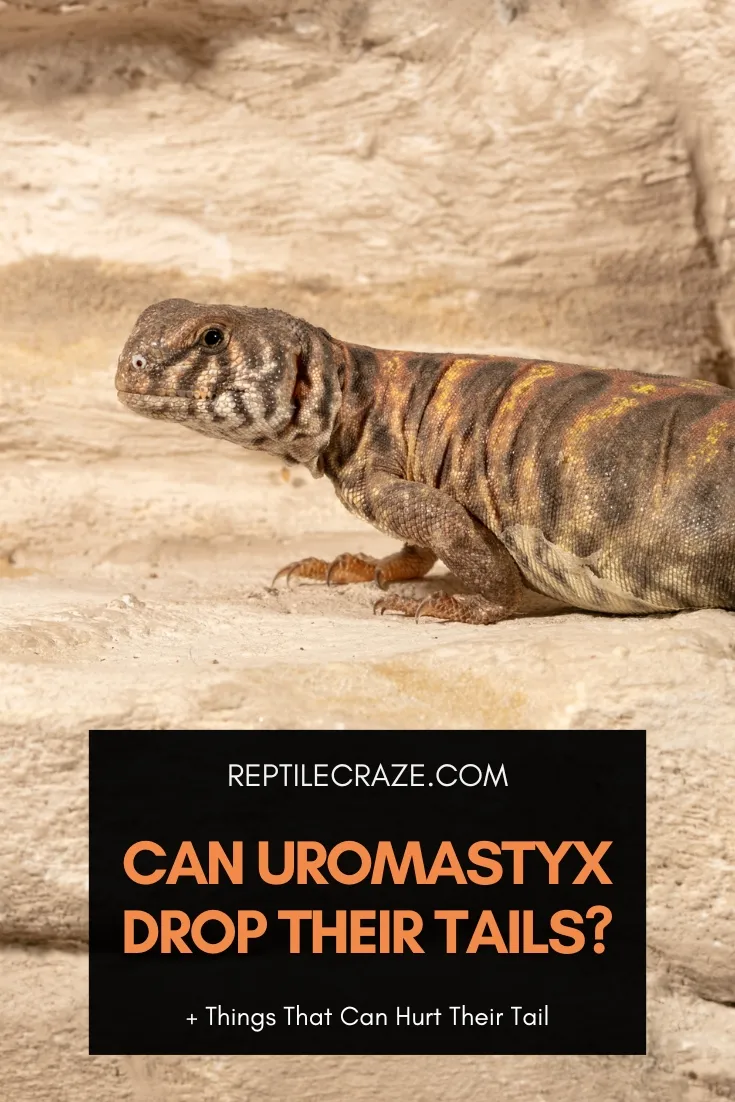
Many lizards are able to drop their tail, which is a defense mechanism. While their tails grow back, they will never look the same as before. What about uromastyx? Are they able to drop their spiky tails?
Uromastyx can’t drop their characteristic spiked tails. They’re in the agamid lizard genus and lack this defense mechanism (along with all other agamids). But it’s not a disadvantage. Discarding a tail wouldn’t benefit an uromastyx and they’ve developed more suitable defensive capabilities.
In this article, we explain exactly why uromastyx can’t drop their tails, why they may have been able to drop their tails many years ago and what can still cause your uromastyx to lose its tail.
Why Don’t Uromastyx Drop Their Tails?
Here are 6 reasons why uromastyx don’t drop their tails:
1. They don’t have the right anatomy
The biological reason why uromastyx can’t drop their tail is that they lack the anatomy that allows many other lizards to drop their tails.
The ability to detach all or part of the tail (referred to as caudal autonomy) is made possible due to pre-formed fracture planes in the tail vertebrae.
However, herpetologists have identified traces of this anatomy in uro embryos. This may indicate that uromastyx possessed caudal autonomy at some point in the past, but have since lost it.
2. It wouldn’t provide an effective means of escape
Caudal autonomy is only useful because it can provide a distraction when a lizard’s under attack. The detached tail, which usually continues moving, diverts the predator’s attention, giving the lizard time to escape.
Little research exists into the specific predators of all types of uromastyx, but predators of adult U. aegyptia include wolves and dogs (for juveniles, it’s monitor lizards, snakes, and strikes).
So, an uro might not be fast enough to reach safety before its predators eat or abandon the discarded tail and resume the pursuit.
Tip: Wanna learn more about uromastyx? Read our uro care guide here!
3. Their tail wouldn’t be a suitable distraction

British herpetologist, E.N. Arnold noted that the usefulness of a dropped tail as a distraction depends on whether the predator will think it’s a good snack.
His comment that “tails or tail fragments that are very small, or spiny, or that do not move much are likely to have little effect” implies that the uro’s spiky tail wouldn’t be a good distraction.
4. It’s not worth the cost
Losing a tail is often accompanied by its subsequent regeneration, and this takes time and energy. Uromastyx are native to arid parts of North Africa, the Arabian Peninsula, Middle East, and India, so they can’t afford this investment.
Many species of lizards use their tails as fat and energy reserves. So losing their tail could put an uro at risk in their harsh natural habitat, especially before hibernating.
5. Their tail provides protection
In the wild, uros stay close to their burrows and hide in them when predators approach.
They use their tail to block the burrow from any predator that tries to follow and use the same technique to protect themselves during sleep. So dropping their tail could leave them more vulnerable to predation.
6. Uros use their tail as a weapon
Uros are more robust than many tail-dropping lizards and their tail has armor. ‘Uromastyx‘ comes from the Ancient Greek words for ‘tail’ and ‘whip’ — which should give you a good idea of they use them!
When threatened, an uro can swing its spiny tail and fend off its attacker. Being territorial, their tail is also handy for intraspecific combat.
Tip: If you want to know what could lead to tail loss or even to death in uromastyx and how to prevent it, read our article on tail rot here!
- Enchi Ball Python: A Unique and Stunning Morph of Python regius - March 27, 2025
- Emerald Tree Monitor: The Enigmatic Green Guardian of the Rainforest - March 26, 2025
- The Egyptian Cobra (Naja haje): A Fascinating Serpent - March 25, 2025
